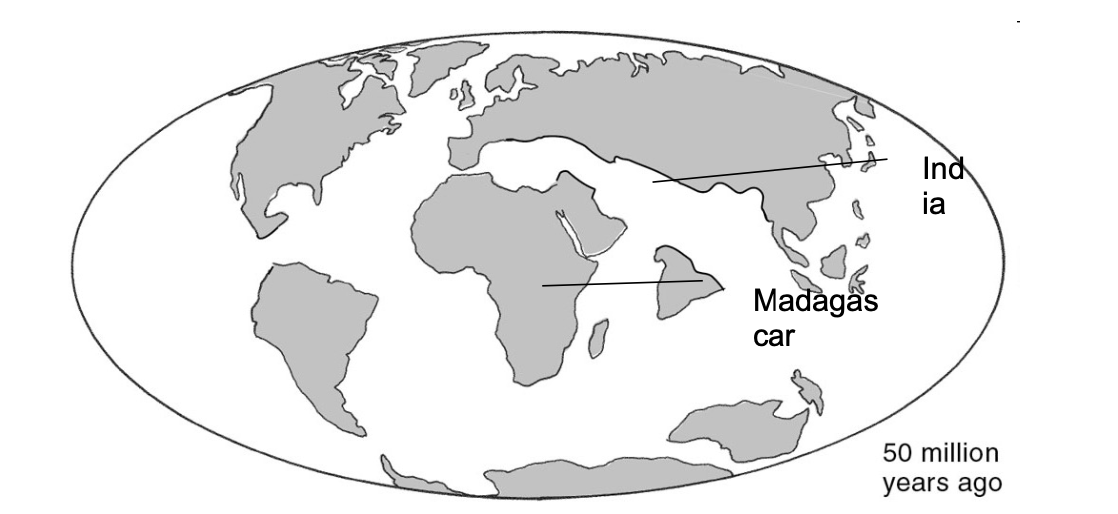Lecture 20- Biogeography
1/21
There's no tags or description
Looks like no tags are added yet.
Name | Mastery | Learn | Test | Matching | Spaced |
|---|
No study sessions yet.
22 Terms
Primary freshwater fishes:
• e.g., lungfishes, paddlefishes, bichirs, extant osteoglossids, minnows, catfishes (except Ariidae), characins, pikes, centrarchids
Secondary freshwater fishes:
• e.g., gars, killifishes, livebearers, cichlids
Diadromous fishes:
• e.g., lampreys, sturgeon, anguillid eels, salmonids
Euryhaline fishes:
• e.g., pupfishes, mollies, striped bass
Saltwater tolerant fish
body size, and whether larvae are planktonic
marine fish dispersability determined by:
Endemism
restriction and uniqueness of certain organisms to a particular place
Fish endemic to Canada
Copper redhorse, Atlantic Whitefish, and Lake Lamprey
Cosmopolitan
Widespread throughout most of the world
Atlantic bluefin, Swordfish
Osteoglossiformes
Split apart before Pangaea split, why we see representatives in all continents as it was still connected when these primary FW fish taxa evolved
did not really occur until after breakup of Pangaea (ca. 180 mya), into Laurasia and Gondwana
• Therefore, more regional differences among most recent teleost groups
Teleost evolution
– Freshwater teleosts that arose here after 180 mya, restricted here (e.g., Esocidae, Percidae, Catostomidae)
– ca. 65 mya, NA and Eurasia separated
– Families or species that arose after that, restricted to one continent or another, if primarily freshwater
• Connections still changed intermittently (e.g., Bering Strait b/w western NA and Eurasia, Isthmus of Panama)
Laurasia (future North America and Eurasia)
• ca. 90 mya, SA, Africa, Antarctic-Australia-New Guinea,
and India-Madagascar distinct landmasses
• By 50–60 mya, India had separated from Madagascar
and both were large islands; Australia had separated
from Antarctica, and New Zealand from Australia
Gondwana (future South America, Africa, Antarctica, India, Australia)

45-55 mya
India collides with Asia in this time
35 mya
Arabia collides with Aurasia in this time
15 mya
continents near present position in this time
Holarctic (Nearctic + Palearctic)
Complete polar, boreal, and temperate northern hemisphere
Freshwater families restricted to Holarctic:
– Polyondontidae (disjunct)
– Catostomidae
– Esocidae (circumpolar – e.g., northern pike; disjunct – e.g., mudminnows)
– Percidae
Diadromous families in Holarctic:
– Petromyzontidae
– Acipenseridae
– Salmonidae
– Osmeridae
Exclusively Nearctic
• Centrarchidae and Ictaluridae
• Percopsiformes (Percopsidae, Aphredoderidae, Amblyopsidae)
• Fundulidae and Cyprinodontidae (euryhaline)
• Relict groups of archaic fishes (e.g., bowfin, gars, hiodontids – although fossil bowfins in Europe, Asia, SA; fossil hiodontids in northeastern Asia)
Palearctic (which includes temperate Asia) also with some endemic groups:
– e.g., two endemic cottoid families in ancient Lake Baikal
• And shares number of FW families with tropical Africa and Asia
– e.g., families (e.g., Cobitidae, Anabantidae, Channidae, Mastacembelidae, Clariidae) perhaps derived from fish carried on the Indian landmass from Africa to Asia and then into temperate Asia and, in some cases (e.g., loaches) in Europe
– Siluridae and Balitoridae also shared by Oriental and Palearctic regions
Middle America
• Central American and southern Mexico
• Interesting mix of North (e.g., centrarchids, cyprinids, ictalurids) and South (cichlids, characids, pimelodids) American faunas with local endemism (Goodeidae, Profundulidae, Poeciliidae, Anablepidae)
• Isthmus and Caribbean islands changing combination of islands and tectonism during most of Cenozoic
• ca. 11–4 mya, permanent land connection established, allowing “Great American Interchange”) but earlier islands had isolated fishes and resulted in widespread endemism
Neotropical
SA isolated for some time prior to reconnection to Middle America
• Separated from Africa ca. 112–150 mya
• Richest in Characiformes (with several endemic families) and Siluriformes (likewise); also many cichlid and gymnotiform spp.
– Characiformes and Cichlidae shared with Africa, but fauna of each continent appear to be monophyletic
• Other Neotropical families closely related to marine groups and probably evolved in inland shallow seas and large lakes of the region
– e.g., Pomatotrygonidae, Clupeidae, Engraulidae, Belonidae, Sciaenidae, Soleidae
• Species rich (ca. 8000 spp. of FW fishes
Oriental
• Land connections to Palearctic and Ethiopian regions
– Although Himalayas form boundary to the north, dry areas of the Middle East form boundary to the west
• Rich in ostariophysan fishes, esp. cypriniforms and siluriforms
• Several endemic catfish families
• Other shared families include Synbranchidae, Mastacembelidae, Channidae
Ethiopian
• Africa (except Atlas mountains), Madagascar, and southern 2/3 of Arabia
• Almost entirely surrounded by ocean
• Endemic families include archaic families of primitive bony fishes:
– Protopteridae and Polypteridae
– Pantodontidae
– Gymnarchidae and Mormyridae
• Other endemic families include Malapteruridae and Mochokidae (Siluriformes)
Australian
• Only ca. 200 FW spp.
• Most in families that are largely marine or estuarine (e.g., gobies, atherinids, catfishes)
• Or diadromous (e.g., lamprey families Geotriidae, Mordacidae) and galaxiids
• Plus three archaic FW fish spp.
– Australian lungfish
– Two osteoglossids (Scleropages spp.)
• Major groups of continental FW fishes lacking (minnows, loaches, catfishes, anabantoids, channids)